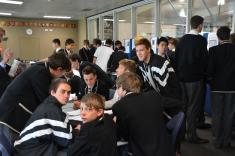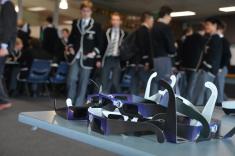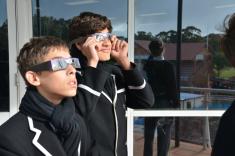In the Spirit of Endeavour we watched the Transit of Venus
The planet Venus passed across the face of the sun last Wednesday 6 June 2012 and it won’t happen again for another 105 years. Transits occur in pairs, eight years apart. The next pair occurs more than a century later. The boys were able to view the event using solar viewing glasses which made the Sun appear like an orange ping-pong ball with a black spot on it. The black spot (Venus) gradually moved up and to the left over a period of six and a half hours later, from 8.14am to 2.44pm.
The Transit of Venus has great significance both scientifically and historically for Australia. If Venus did not make occasional transits across the Sun, the people of Australia would probably not speak English! The first voyage of Captain Cook was organised so that he could observe the transit from Tahiti in June 1769. As he was already in Pacific Ocean he continued travelling south-west and discovered Australia in 1770. By timing the transit from a wide variety of locations it is possible to calculate the distance from the Earth to the sun. That is why Captain Cook and many others were sent to far flung locations in the 1760s.
The transit was timed very precisely by surveyors Charles Mason and Jeremiah Dixon at the Cape of Good Hope in 1761. They were subsequently employed in 1763 to mark the boundary between the ‘free states’ (North) the ‘slave’ (South) in the USA. This is now known as the Mason-Dixon Line.
From the information gathered in 1761 and 1769 scientists calculated a distance of 151 million kilometres to the Sun. The currently accepted value is 149.6 million kilometres.
If you missed it, sadly you will never see another. The next transit of Venus is in 2117!
Mr Andrew Davies
Science Department












